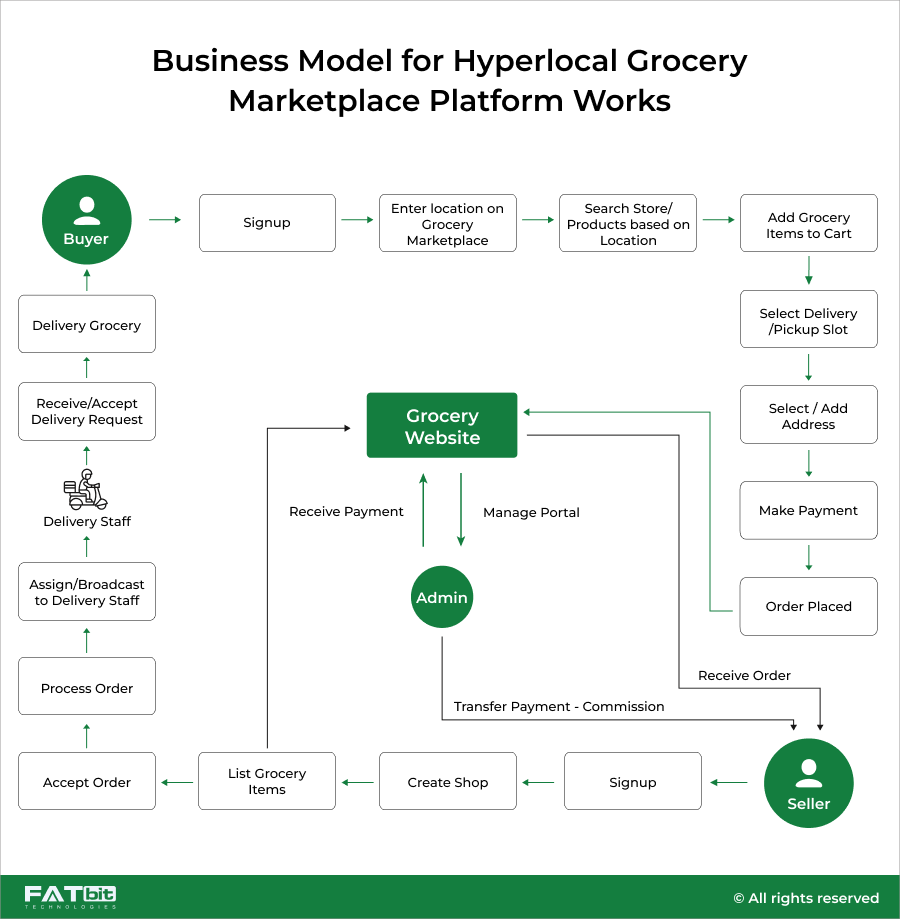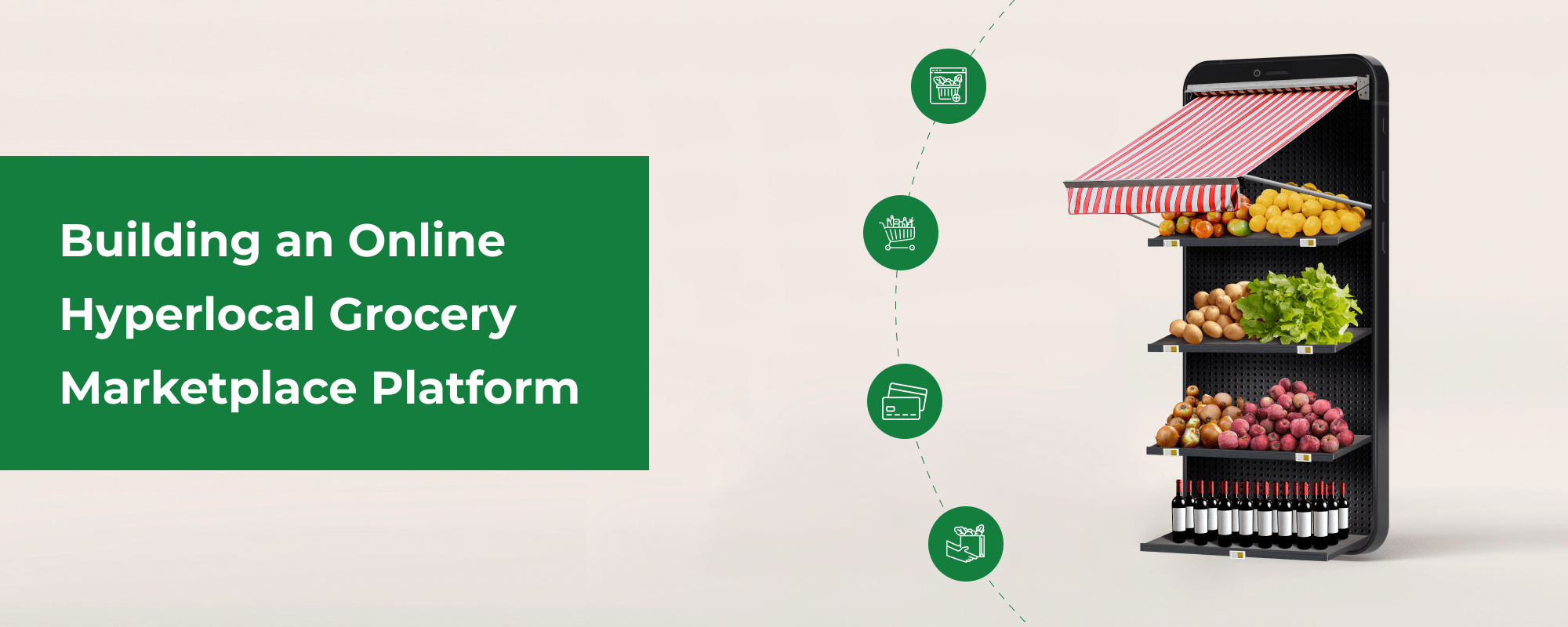What is an Online Hyperlocal Grocery Marketplace Platform?
An online hyperlocal grocery marketplace platform is a digital space that connects buyers and sellers in a specific geographical area, facilitating quick deliveries. The primary characteristic of this model lies in the speed at which the groceries can be delivered to the customers right at their doorsteps. These platforms offer a diverse catalog of products including fresh produce, packaged goods, dairy, and more.
In a nutshell, online hyperlocal grocery delivery marketplaces benefit both local businesses by expanding their reach and the customers by providing rapid access to products and services within their neighborhood.
Key Trends Driving Online Hyperlocal Grocery Market Growth
- Demand for Convenience & Quick In-Time Delivery: Customers are increasingly seeking convenience in their grocery shopping experiences. The ability to order a wide range of groceries online from the comfort of their home and get them delivered is a key preference considering the busy lifestyles of individuals. This demand for on-time and quick delivery is the primary driver in the online hyperlocal market’s rising growth.
- Hyper-Personalization: Customizing the shopping experience to individual preferences is a significant trend driving growth in the hyperlocal market. Online hyperlocal businesses can utilize data to understand customer behaviors and preferences and provide personalized recommendations, discounts, and more, enhancing customer satisfaction and retention.
Leading Players in the Online Hyperlocal Grocery Delivery Market
The online hyperlocal grocery delivery services market is dominated by several key players. Each of these market leaders mentioned below follows distinct strategies and possesses strengths, continually striving to enhance customer satisfaction in this dynamic and ever-expanding market.
Grubhub Inc.
Grubhub Inc., founded in the year 2004, is a prominent player in the online hyperlocal grocery market known for its food delivery services. It began by connecting customers with local restaurants for local food delivery. Over time, it expanded its services to include grocery delivery from nearby stores, catering to the increasing demand for convenience in grocery shopping. The platform enables users to browse various grocery items available in local grocery stores, place their orders, and get them delivered.
Instacart
Instacart has established itself as a leading player in the hyperlocal grocery market by offering on-demand grocery delivery services. It partners with various grocery retailers, allowing buyers to shop for items from their favorite local stores via the Instacart app or website. Customers can effortlessly choose items, select delivery times, and get the products delivered to the specified location. Furthermore, Instacart’s flexible delivery options, extensive network of partner stores, and personalized shopping experiences have contributed to its widespread popularity in the hyperlocal grocery delivery market.
Build an Online Hyperlocal Grocery Marketplace Like Instacart
Postmates
Postmates is another on-demand hyperlocal grocery delivery platform that has a strong presence in the hyperlocal market. It enables customers to order groceries from anywhere anytime within the city and has its courier networks to deliver orders to the customer’s doorsteps.
DoorDash
DoorDash is again one prominent player that has swiftly established its presence in the competitive hyperlocal grocery delivery arena. Leveraging its extensive delivery infrastructure and huge customer base, DoorDash seamlessly expanded its offering to groceries.
What sets DoorDash apart is its commitment to offering a wide array of products from local stores and national chains, coupled with efficient and timely delivery services. This combination of convenience, diverse product offerings, and reliable logistics has solidified DoorDash’s position in the hyperlocal grocery delivery market.
GoPuff
GoPuff, founded in 2013, is a hyperlocal marketplace platform that delivers everything from food to home essentials, snacks, and beverages. It has expanded its services to over 650 cities in the United States.
Its unique selling proposition lies in its ability to deliver an extensive range of goods within minutes, 24/7. This exceptional delivery speed, coupled with diverse offerings has set GoPuff apart from competitors. Additionally, its strategic partnerships with local warehouses have enabled efficient inventory management and minimized delivery times.
Having explored the top players in the online hyperlocal grocery market, it’s vital to understand how an eCommerce hyperlocal model works. Like other online platforms, the hyperlocal marketplace has admin, sellers, buyers, and delivery personnel.

Role of Admin(s):
- Admin sets up the infrastructure including the website/app and manages the overall functioning of the marketplace.
- They onboard sellers onto the online hyperlocal grocery platform after verification and approval, maintaining a catalog of products, and managing seller relationships.
- Furthermore, they earn money through various means such as charging a commission on sales, subscription fees from sellers, featured listings, or advertising.
Role of Sellers:
- Sellers register themselves on the marketplace, create profiles, and list their offerings.
- They process and prepare orders for pickup or delivery as per buyer requests.
- Further, the sellers can communicate with the delivery personnel for the timely fulfillment of orders.
Role of Buyers:
- Buyers access the platform via the website or mobile app, browse the listings, and easily search for locally preferred products.
- They place orders by making payments online or via cash-on-delivery mode.
- Upon order placement, the seller receives and accepts the order. They pack the order, ready it for shipment, and notify delivery persons about the pick-up and drop-off schedules.
Role of Delivery Staff:
- Delivery agents pick up the order and deliver it to the customer at their doorstep within the specified timeframe.
- They can communicate with the buyers and sellers regarding pickup, transit, and delivery details.
- Delivery staff earn income through wages or delivery fees, have flexible working hours, and potentially receive incentives based on the number of deliveries completed.
Essential Features of Online Hyperlocal Grocery Marketplace
Now, let us explore key platform features that allow hyperlocal marketplaces to meet user needs in this domain. All these features collectively help to efficiently manage operations, enhance user experience, and ensure the smooth functioning of an online hyperlocal grocery marketplace.
Features for Admin
- Admin Dashboard: Admin(s) can view the stats of products, seller inventories, users, payment methods, and sales statistics.
- Delivery Management: Enables admin(s) to manage deliveries either by manual assignment or broadcasting to the delivery staff. Also, offers the ability to provide access to the sellers to manage order deliveries.
- Commission Management: Admin(s) can define the commission on each product listed on the platform.
- Payment Gateways: Allows integration of various payment gateways like Stripe, and PayPal for seamless transactions.
- Multiple Revenue Channels: Admin(s) can increase profitability via diversified income streams like subscriptions, commissions, advertisements, affiliate partnerships, and featured listings.
- Reports & Analytics: Admin(s) can track and analyze data such as sales, customer behavior, and performance of products.
Features for Sellers
- Seller Dashboard: Sellers can view multiple metrics such as sales, revenue generated, and number of orders received, delivered, or returned.
- Bulk Import/Export: Sellers can efficiently upload or download .CSV files of products including information such as catalogs of categories and brands.
- Catalog Management: Provides a simple and intuitive catalog system to better categorize products and help buyers find within a few clicks.
- Order Adjustment: Sellers can swap unavailable items in an order by asking the buyer for approval, avoiding order cancellations.
Features for Buyers
- Easy Registration: Allows users to easily register and log into the marketplace with minimal steps to follow.
- Pickup Management: Gives freedom to buyers to select the pick-up slot and collect online orders directly from the store.
- Multicart: Simplifies the buying process and saves buying time by enabling buyers to buy from multiple stores simultaneously.
- Guest User Checkout: Buyers can make purchases without the need to create an account or log in, easing the buying process for those who prefer not to register.
- Advanced Search Functionality: Allows buyers to filter and search products based on several parameters like store types, budget, and delivery expectations.
- Order Management: Allows buyers to track the status of their orders, manage their delivery address, and track and cancel orders.
- Auto-Detect Geolocation: Auto-detects buyer’s location and displays the nearby stores for ease of grocery shopping.
Features for Delivery Staff
- Dashboard: Equipped with all the order details, earnings, rewards or credits, and ratings.
- Define Radius: Delivery personnel can set the maximum distance or area they’re willing to deliver the orders to.
- Push Notifications: Helps delivery staff receive alerts and stay updated on new orders or other important information.
- Delivery Order Management: Provides all the essential information like order IDs, distance, location, and booking details to help drivers make informed decisions.
Launch a Feature-Rich Online Grocery Hyperlocal Marketplace
How Much Does It Cost to Build an Online Hyperlocal Grocery Marketplace Platform?
Before you begin building an online hyperlocal grocery marketplace, it is vital to take into consideration the development costs associated. Usually, the cost is influenced by the chosen development approach: either custom-built or leveraging readymade software.
1. Cost of Building the eCommerce Grocery Marketplace From Scratch
The custom-built development approach requires more time due to coding, designing, testing, and iteration. Hence, hiring a team of experts or outsourcing the development needs add to the costs. As a result, building the online hyperlocal grocery marketplace from scratch will require time and money investment, leading to increased time-to-market of the marketplace.
2. Cost of Leveraging Turnkey Online Grocery Software
Alternatively, leveraging readymade eCommerce grocery software is a cost-effective way to build an online hyperlocal grocery marketplace. It consists of all the essential features, eliminating the need to hire experts and reducing the time-to-market and development costs. Furthermore, such turnkey software charges a one-time licensing fee, saving on recurring charges or monthly payments and costs would be associated more with the features you wish to include in the marketplace.
Growcer: The Ideal Solution to Build Your Online Hyperlocal Grocery Marketplace
Growcer is a self-hosted grocery eCommerce software that comes equipped with all essential features including the aforementioned. This white-label, highly scalable, and fully customizable solution enables entrepreneurs to quickly launch the platform.
It offers intuitive mobile apps for Android and iOS for buyers and the delivery staff to achieve a competitive edge, making it an ideal software choice. Also, Growcer has helped many global clients like RX Delivered, Pravasi Cart, Soukers, and more develop online hyperlocal grocery marketplace platforms for their businesses.
Other key aspects that make Growcer the right choice for entrepreneurs include:
- BOPIS (Buy Online, Pick up in Store)
- Full source code ownership
- No recurring charges
- 1-year free technical support
Launch a Scalable Hyperlocal Grocery Marketplace Platform With Growcer
In today’s fast-paced world, where convenience is highly valued, the idea of launching an online hyperlocal grocery marketplace holds immense potential. However, to succeed, integrating above mentioned unique key features catering to all users is crucial. Besides, for a comprehensive solution comprising these essential features and functionalities, Growcer software stands out as an ideal choice. This readymade software facilitates the quick launch of an online hyperlocal grocery marketplace similar to Instacart, Postmates, and Grubhub.




